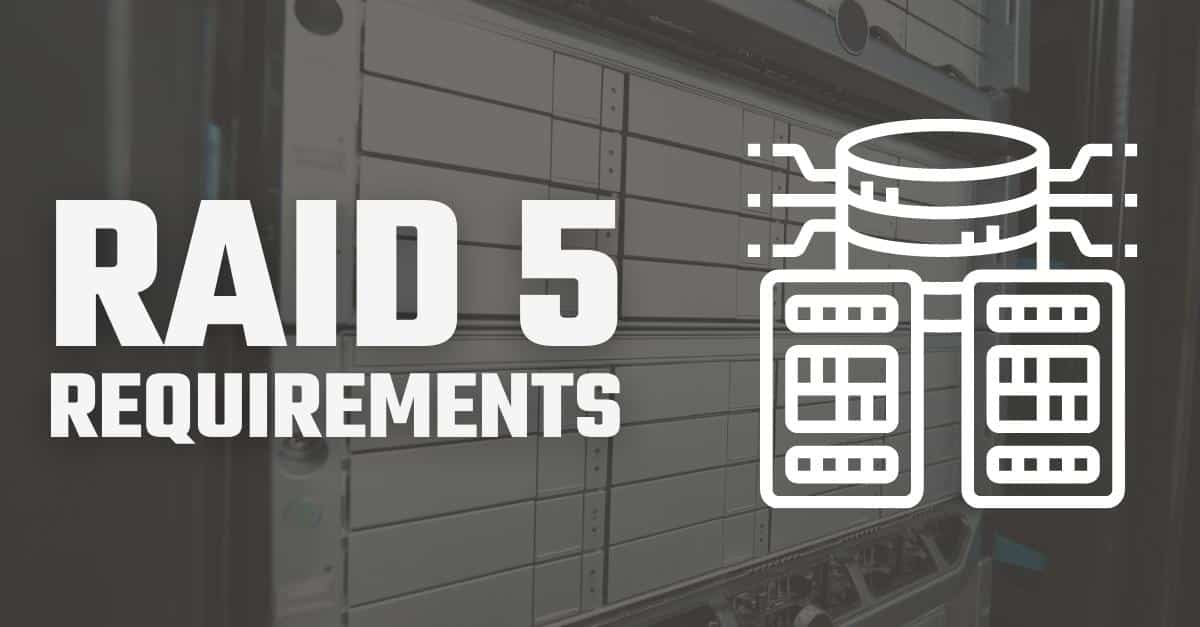What are the RAID 5 Requirements?

What do you do if you’re a small to medium-sized business—or even a freelancer or consultant— who can’t afford the capital investment to buy high-capacity servers? You still need your drives to deliver fast read and write speeds with ample storage space, but the cost is so prohibitive! Depending on your needs, the answer might be a RAID 5. But what are the RAID 5 requirements?
What is a RAID?
Storage solutions using a Redundant Array of Independent Disks (RAID) are an excellent way to maximize multiple hard drives’ performance. As we’ve discussed before, RAID configurations harness the power of software and hardware so a group of hard drives can work together. The result is an affordable, high-performance data storage system.
Different types of RAID configurations have their own advantages, drawbacks, and requirements. Today we’re going to explore RAID 5, because it’s a popular choice and fairly easy to implement. The RAID 5 configuration yields lightning-fast read times, and if you do experience a RAID 5 disk failure, data recovery is possible. That’s because this array splits data into tiny pieces and divides those pieces among the connected drives. Dividing and saving the data this way is called parity.
Of course, there are a few things you should know before organizing your hard drives into a RAID 5. Every array has specific conditions needed to work well, and RAID 5 is no different. So what do you need to know before setting up your RAID 5 hard drive configuration?
The 4 RAID 5 requirements you need to know
RAID 5 Requirement #1: The right amount of drives
How many physical disks are required to implement RAID 5? With a RAID 5 configuration, you can connect three to 16 drives, but four is the most common number of hard drives used in this array.
Even though the minimum drives for RAID 5 is three, most users opt for four drives because of speed, fault tolerance and storage capacity. It’s a little bit counterintuitive, but the more hard drives connected to the array, the slower the read and write speeds become. And, the more drives you add, the more complicated data recovery will be if one of the hard drives fails.
At the same time, the fewer drives connected to the array, the more storage capacity is lost. For example, available storage capacity decreases by 33% when using three hard drives. So, if you connect three 1TB hard drives (total capacity of 3 TB) in a RAID 5 configuration, you’ll only have 2 TB of usable storage.
There’s still storage loss if you aren’t using the minimum disks for RAID 5, but the reduction isn’t as significant. RAID 5 configurations lose the storage capacity of one of their connected drives no matter how many disks are connected. So the trick is striking a balance between your storage needs, performance expectations and risk tolerance.
RAID 5 Requirement #2: The right storage capacity
An essential part of determining how many drives for a RAID 5 configuration is considering the overall storage capacity. With this array, it doesn’t matter if there are three or 16 hard drives connected, they all must have the same storage capacity.
Why? Because if the connected hard drives don’t have identical disk space, the drives will operate as if they have the capacity of the smallest connected drive. Wasting valuable storage space is a big no-no and should be avoided at all costs!
RAID 5 Requirement #3: A dedicated hardware controller
Some RAID configurations rely on software to manage and maintain their systems. Others use hardware-based solutions to ensure their functioning properly. In the case of RAID 5, using a hardware controller is strongly encouraged.
RAID 5 hardware controllers are actual, physical chips added to the motherboard or stand-alone expansion cards. They’re useful because they can calculate parity data before writing the data across all the disks. Hardware controllers manage each disk’s physical space and optimize the configuration’s performance by providing an additional disk cache.
RAID 5 Requirement #4: Fault tolerance
You’ll definitely want to consider fault tolerance before configuring your RAID array. RAID 5 actually has a decent fault tolerance because the system is designed to operate even when a drive is down. And, should you lose data as a result, you’ll be able to piece together lost information using data from other drives in the parity.
Understanding this RAID 5 requirement is critical because, unlike other RAID configurations, a RAID 5 system can only tolerate one drive’s loss. If multiple drives go down simultaneously, the chances of data recovery are much lower. Recovery also becomes more complicated and time-consuming with every additional drive added to the array.
Choosing the right number of drives for your RAID 5 configuration is so important because the number of drives directly impacts fault tolerance.
If you’re facing a failed RAID 5 or have issues with any other RAID configuration, we can help determine if your data is recoverable. If your RAID array fails, contact DriveSavers right away!




